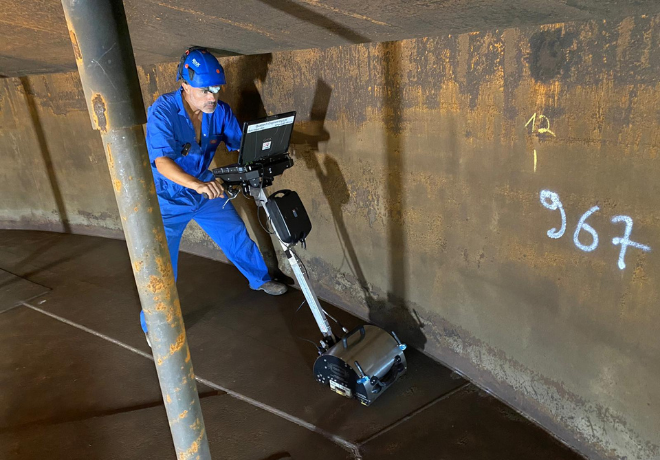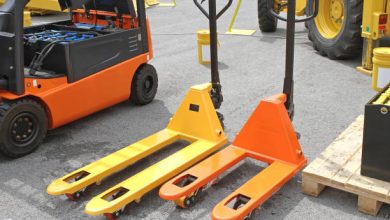Essential Tools And Techniques For Api 653 Tank Inspections

If you are involved in the maintenance and inspection of storage tanks, then you know how important it is to ensure they remain safe and reliable. One essential tool for this task is API 653, which provides guidelines for inspection, repair, alteration, and reconstruction of aboveground storage tanks. By following these guidelines, you can help prevent leaks, spills, explosions or other hazardous situations.
However, simply having the API 653 standard isn’t enough. You also need to have a good understanding of the tools and techniques required to conduct thorough inspections. In this article, we will cover some of the essential tools and techniques that you should be familiar with when conducting API 653 tank inspections.
These include ultrasonic thickness testing (UTT), magnetic particle testing (MPT), visual inspection (VI), among others. By mastering these tools and techniques, you’ll be better equipped to maintain safe storage tanks that serve their purpose well while protecting both people and the environment around them.
Key Takeaways
– Visual inspection is crucial for detecting early signs of corrosion, leaks, cracks, dents, and hazards, and requires proper equipment and lighting.
– Accurate reporting and documentation are important for recording and addressing issues found during inspection, identifying trends over time, and effective communication among stakeholders.
– Safety and accuracy are paramount, with personal protective equipment (PPE) and safety protocols, hazardous materials involved, clear communication and collaboration among team members, and proper training and certification necessary.
– API 653 certification demonstrates knowledge and skills as an inspector, with high-quality inspections ensuring the safety and integrity of storage tanks in various industries.
Overview of API 653 Tank Inspections
You’re going to love learning about the overview of API 653 tank inspections, as it’s an essential part of understanding the tools and techniques used in this industry.
The American Petroleum Institute (API) developed API 653 Tank Inspection Standards to ensure that aboveground storage tanks are properly maintained and inspected regularly. These standards cover everything from inspection frequency requirements to repair methods for tanks that have been found to be deficient.
It’s crucial for tank owners and inspectors to understand these standards thoroughly, as they play a significant role in maintaining the structural integrity of tanks and ensuring that they operate safely.
Now, let’s move on to discussing one important tool used in API 653 tank inspections: ultrasonic thickness testing.
Ultrasonic Thickness Testing
When conducting ultrasonic thickness testing, you’ll use a handheld device to measure the thickness of the tank’s walls. This method is highly accurate and non-destructive, allowing for detailed information on the tank’s condition without causing any damage.
Ultrasonic thickness measurement can detect changes in wall thickness caused by corrosion or other forms of degradation. Corrosion detection is one of the key benefits of ultrasonic thickness testing. By measuring the thickness at several points across the tank’s walls, inspectors can identify areas where corrosion has occurred. This allows for targeted repairs to be made before they become more serious issues.
Once this step is complete, magnetic particle testing can be used to further assess any potential issues with the tank’s structure.
Magnetic Particle Testing
Magnetic particle testing is a highly effective way to identify potential issues with metal structures. This technique involves the use of magnetic fields and iron oxide particles to detect surface and slightly subsurface defects in ferromagnetic materials.
The process begins by applying a magnetic field to the material being inspected, which causes any defects or cracks to become magnetized. Iron oxide particles are then applied to the surface, which will be attracted to any areas where there is a change in magnetic flux density due to the presence of a defect.
There are several different magnetic particle testing techniques that can be used depending on the specific needs of an inspection. Some methods involve using wet fluorescent particles, while others use dry powder or visible dye particles.
Magnetic particle testing equipment typically includes a power source for generating the magnetic field, as well as applicators for applying the iron oxide particles and various types of lighting for inspecting the results. With proper training and experience, this technique can provide valuable insights into potential issues with metal structures before they become major problems.
Visual inspection is another important step in API 653 tank inspections after conducting magnetic particle testing.
Visual Inspection
When conducting API 653 tank inspections, visual inspection is a crucial part of the process. It allows you to identify any visible signs of damage or corrosion that may not be detected through other testing methods.
To conduct an effective visual inspection, ensure proper lighting and access to all areas of the tank. Use tools like mirrors and magnifying glasses to aid in your examination.
Finally, reporting and documentation are important steps in ensuring that any issues found during inspection are properly recorded and addressed in a timely manner. Make sure to use contractions throughout the paragraph.
Remember to double space between each complete sentence on its own line for logical grouping.
Importance of Visual Inspection
You can’t underestimate the significance of visual inspection when it comes to ensuring the safety and integrity of your tanks. It’s a fundamental aspect of API 653 tank inspections, as it enables you to identify any physical defects or damages that may compromise the structural integrity of your tanks.
Visual inspection is essential because it provides a means for detecting early signs of corrosion, leaks, cracks, dents, and other potential hazards that may lead to catastrophic tank failure.
The benefits of conducting visual inspections are numerous. For one, they help prevent costly downtime by identifying problems before they become severe enough to require extensive repairs or replacement. Additionally, regular visual inspections can extend the life of your tanks by catching minor issues before they escalate into significant structural damage.
With adequate training and experience in performing visual inspections, you’ll be able to spot even minute details that could signal a problem with your tanks. In the next section, we’ll go over some tips for conducting effective visual inspections on your tanks.
Tips for Conducting Visual Inspection
If you want to make sure your tanks are in good condition, it’s important to know some tips for conducting visual inspections.
One of the first things you need is proper inspection equipment such as flashlights, mirrors, and magnifying glasses. These tools can help you see areas that are difficult to access or inspect. Make sure your equipment is clean and functioning correctly before you start the inspection.
Another important factor during visual inspections is lighting techniques. Good lighting will help you identify any defects or corrosion on the tank’s surface. You can use natural light sources like sunlight or artificial lights like LED lamps that provide brighter illumination. By using different angles of light sources, shadows can be created which reveal small pits and cracks present on the tank surface that may not be visible under normal conditions.
Remember, a well-lit tank inspection will provide more accurate results, leading to better decisions about maintenance and repairs needed for your tank.
When conducting a visual inspection with proper equipment and lighting techniques, it becomes easier to detect any damages present on the tank’s surface accurately. This information can then be used for reporting and documentation purposes without missing out on any critical points necessary for repair or maintenance procedures required by API 653 standards.
Reporting and Documentation
Let’s dive into the importance of proper reporting and documentation for ensuring the longevity and safety of your tanks. Record keeping is essential in maintaining an accurate history of tank inspections, repairs, and maintenance activities. This information provides a record of previous issues and can be used to identify potential problems before they become major concerns. Additionally, it can help with compliance and regulatory requirements.
Data management is another critical aspect of reporting and documentation. Accurate data collection during tank inspections ensures that all necessary information is recorded correctly. The data collected must be securely stored to maintain its integrity, as well as for reference purposes in future inspections or audits. Properly managing this information will also assist in identifying trends over time, allowing operators to make more informed decisions about their tanks’ maintenance needs.
With proper record keeping and data management practices, you can ensure the longevity and continued safety of your API 653 tanks.
Moving forward to the subsequent section about ‘best practices for api 653 tank inspections,’ it’s important to note that effective communication between inspectors, operators, engineers, and other stakeholders is key to ensuring successful outcomes from tank inspections.
Best Practices for API 653 Tank Inspections
When conducting API 653 tank inspections, it’s important to follow best practices to ensure safety and accuracy. This includes taking necessary precautions like wearing appropriate personal protective equipment (PPE) and following established safety protocols.
Communication and collaboration are also key factors in ensuring a successful inspection, so make sure to establish clear lines of communication between all parties involved.
Additionally, it’s important for inspectors to have proper training and certification in order to accurately assess the condition of the tanks and provide reliable recommendations for maintenance or repairs.
Safety and Precautions
To ensure your safety during API 653 tank inspections, it’s crucial to follow proper safety measures and wear the appropriate protective equipment. The inspection process involves working with hazardous materials, such as flammable liquids and toxic gases, which can be harmful to your health if not handled with care.
Protective equipment, such as gloves, goggles, hard hats, respirators, and safety shoes, are essential tools that should always be worn during an inspection. Additionally, it’s vital to have a clear understanding of the site-specific hazards before beginning any work.
By taking these precautions seriously, you’ll be able to minimize the risks associated with tank inspections and ensure a safer environment for everyone involved.
Moving forward into the subsequent section about “communication and collaboration,” maintaining effective communication between team members is crucial in ensuring a successful inspection.
Communication and Collaboration
Effective communication and collaboration among team members is key to ensuring a smooth and efficient inspection process. Communication techniques such as clear and concise verbal instructions, written reports, and visual aids allow for effective exchange of information among team members.
In addition, it’s important to establish clear roles and responsibilities for each member of the inspection team to avoid confusion or duplication of efforts. Team coordination is also critical in achieving a successful inspection. This involves regular meetings among team members to discuss progress, identify issues or concerns, and plan next steps.
It also requires flexibility in adapting to unexpected situations that may arise during the inspection process. By maintaining open lines of communication and working together towards a common goal, the entire inspection process can be carried out efficiently and effectively.
As you move on to the subsequent section about training and certification requirements, remember that effective communication and collaboration are skills that can be honed through practice and experience.
Training and Certification Requirements
You’ll need to meet certain requirements for training and certification in order to become a qualified API 653 tank inspector. The certification process involves passing an exam that tests your knowledge of tank inspection procedures, regulations, and safety protocols.
To prepare for this exam, you can enroll in training programs offered by industry organizations like the American Petroleum Institute or NACE International. These programs cover topics such as tank design and construction, corrosion control, non-destructive testing techniques, and inspection methodologies.
In addition to completing these training programs, you will also need to accumulate a certain amount of work experience before you can become certified. This typically involves working under the supervision of a certified inspector or engineer for several years while gaining hands-on experience with different types of tanks and inspection methods.
Once you have met all of the requirements for certification, you’ll be able to take the API 653 exam and demonstrate your knowledge and skills as an inspector. By completing this process, you’ll be better equipped to provide high-quality inspections that ensure the safety and integrity of storage tanks in various industries.
Conclusion
Congratulations! You’ve now gained a deep understanding of the essential tools and techniques for API 653 tank inspections. Ultrasonic thickness testing, magnetic particle testing, and visual inspection are all crucial components of ensuring that your tanks are in good condition and meet industry standards.
To ensure the best results for your API 653 tank inspections, it’s important to follow best practices such as thorough planning, proper training, and regular maintenance. By implementing these practices along with the aforementioned techniques, you can maintain the safety and integrity of your tanks while also avoiding costly repairs or potential accidents.
Remember to always prioritize safety when conducting any type of tank inspection.
With these tools and techniques at your disposal, you can confidently assess the condition of your tanks while minimizing risks and maximizing efficiency.




